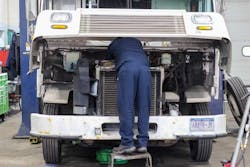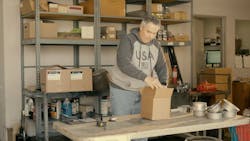Some fleets view the maintenance department as a cost center, but the best ones also view it as an opportunity center—an opportunity to make smart buying decisions that ultimately help drive fleet profitability.
“I’m never going to make money for the company, at least not directly,” said Ernest Acevedo, director of fleet maintenance and onboard technologies at Massachusetts-based Boyle Transportation. “But by limiting unscheduled repairs, you’re keeping everything going and everybody happy. That is my main job.”
Limiting those unscheduled repairs starts with routine preventive maintenance, of course, but also involves the quality of parts you use when making scheduled and unscheduled repairs. Scouring the ends of the earth to find a cheaper part doesn’t automatically earn you a gold star as a maintenance manager. A fleet may be able to cut costs when initially buying a replacement part, but its true value must be measured not only by price but also by performance, durability, and availability. This makes the decision on whether to buy an OEM versus aftermarket replacement part more complex. It can feel like a never-ending game of tug of war, so we spoke with experts to figure out which side has the edge.
See also: The post-pandemic parts plan: Shop solutions
OE or aftermarket?
“Some fleets will opt for the OE part every time,” said Kevin Lydic, VP of business development at FinditParts, an online provider of heavy-duty OE and aftermarket parts. “But with the longer truck life cycles we’re seeing now, more fleets are more interested in aftermarket parts when a vehicle is getting closer to end of life.”
Lydic, who has been in the industry for a decade, also noted the quality of aftermarket parts have improved.
“Several providers are competing at a really top-notch level today,” he said. Nevertheless, some fleets continue leaning toward OE parts as a vehicle gets older.
“We did a study a few years ago, and using better OE parts comes back to a net-zero if not a financial gain for our company,” said Kurt Dunn, senior fleet technical adviser at Pitt Ohio, an LTL trucking fleet that operates in the Northeast, Mid-Atlantic, and Midwest. “We run most of our trucks to a million miles or more. We’ve found that using OE parts becomes really important to keep a vehicle on the road up until the day it retires.”
Safety may also influence where a fleet is willing to look on the price/quality spectrum. Brakes, for instance, represent an area where some fleets don’t want to take too many chances.
“We have the mindset that brakes are a primary safety function on a unit,” said Jason Dolence, manager of parts and warranty at Pitt Ohio. “That’s why we do not deviate from OE replacement components when it comes to braking systems, which includes things like brake linings and shoes.”
Boyle’s Acevedo is leery about venturing away from OE when it comes to core engine components. He categorizes those items “as commonly replaced but capable of causing a lot of headaches and unscheduled repairs.”
So what’s his advice?
“If you find something that works and is reliable, stick with it,” Acevedo advised. “That’s typically a top-of-the-line OE part.”
Acevedo has designated a second parts category as well. These are regularly replaced, PM-driven items that provide some opportunity to shop around.
However, whether you’re talking about oil and filters, batteries, bumpers, tires, or other high-wear items, the only way to know if you’re purchasing the perfect part is if you measure and analyze how it performs.
Test, measure, & move forward
Pilot programs are a popular way to begin trying out an alternative, less expensive part.
“A pilot program allows you to put a new part through the normal paces of the truck to see how it holds up,” said Willie Reeves, director of maintenance at PacLease, Paccar’s leasing company that provides full-service lease, rental, and maintenance programs for Kenworth and Peterbilt trucks.
When piloting a new part, Acevedo said it’s important to maintain the same PM schedule as the original. Extending the trial through two or three PM intervals to guard against any one-off flukes also helps. “It’s important to have some processes in place to help determine if the alternate part is holding up to the same standard as the original,” Acevedo said. “It’s more about durability and dependability than money, regardless of whether it’s an OE or aftermarket part.”
See also: Equipment leasing and rentals take new turns in 2023
A good software system that can measure usage and failure rates can further assist maintenance managers in accurately evaluating the performance and true cost of an alternative part.
“Without a good system, you might assume a part is working properly because you haven’t heard any complaints,” said Michael Dominguez, VP of business operations, procurement, and fleet management at Transervice, a provider of freight management, fleet leasing, and contract maintenance services. “With our system, we can see if there is an increase in spend for a certain component. Then we can dig into the data to get to the root cause of the problem. If the reason for the failure is that the part isn’t good enough, we will pull the plug right away.”
This article was originally published on FleetMaintenance.com.
About the Author
Gregg Wartgow
Gregg Wartgow covers the trucking and maintenance industries for Endeavor Business Media's Commercial Vehicle Group, which includes Fleet Maintenance and FleetOwner.


